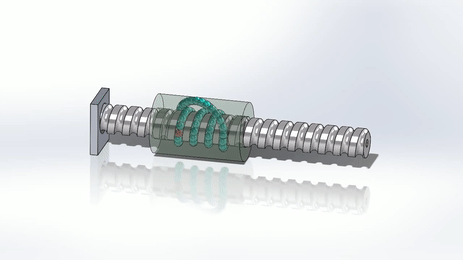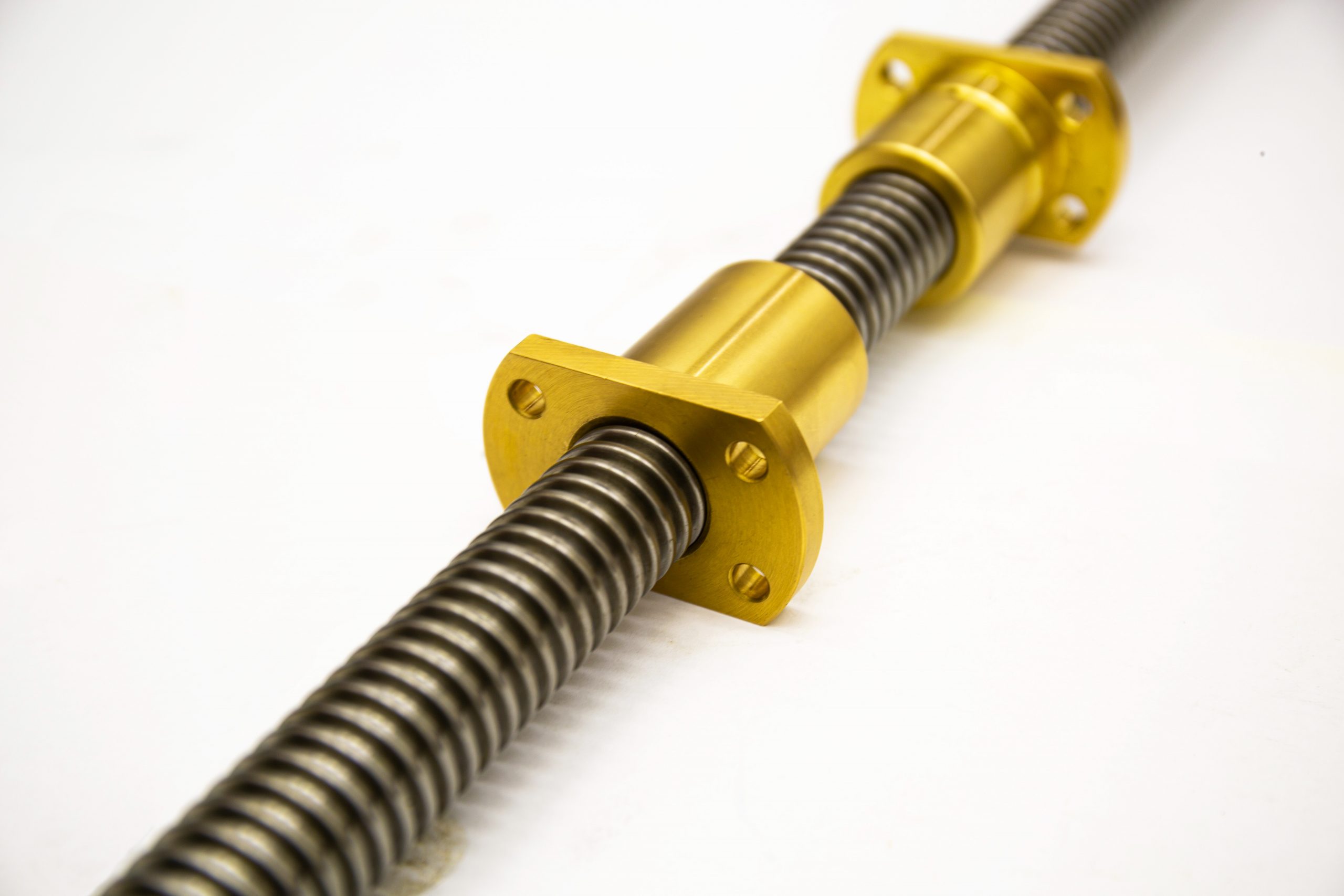Structural Differences
Ball screws and lead screws are common parts used in linear motion systems. The general function of both is the same – to translate rotary motion to linear motion down a screw shaft. Now let us discuss the differences in their structure.
A ball screw assembly is made up of a screw shaft and a nut that contains ball circuits. These circuits contain steel balls that run along the threads of the shaft and recirculate back into the circuit (refer to GIF below). A lead screw assembly consists of a trapezoidal or acme threaded screw shaft coupled with a lead screw nut. When the nut travels down the lead screw shaft, the internal threading of the nut comes into full contact with the grooves of the shaft. In other words, a lead screw assembly contains no steel balls, unlike ball screws.


GIF 1: An illustration of the internal structure of a ball screw nut traveling down a ball screw shaft.
Image 1: An SNB lead screw assembly from Shafttech, consisting of bronze nuts (TMK 25 SNB and TMK 25 OH SNB) on a 2meter long S45C trapezoidal lead screw (TM 25×2000 SNB).
What are the benefits of each?
Ball Screw
A ball screw nut is designed in a way to achieve a low friction, smooth and precise linear motion. Therefore, ball screws are used in industrial applications with higher positional accuracy and greater axial loads for robotics, semiconductors, CNC machinery and other contract manufacturing processes. In these applications, ball screws are often used in conjunction with other high precision components like linear guides to form linear actuators, which are in turn used in complex XYZ positioning tables.
Much like a ball bearing, the steel balls within the ball screw nut provide lesser friction as compared to lead screws. This means that lesser torque is required to achieve linear motion. This makes ball screws much more efficient and durable, therefore able to withstand repeated cycles of operation.
Lead Screw
A lead screw is generally regarded as a more cost-effective solution to achieve linear motion, but it is mostly used in simple positioning applications that do not require high loads or accuracy.
If you have a vertical application in your system, you may consider lead screw as they have a self-locking mechanism to prevent back drive. But this also means that more external force needs to be applied to power the movement of the nut.
Another advantage is that lead screws are mostly maintenance-free and quieter because there are no steel balls in the nut. However, the higher surface contact between the nut and screw also generates high heat and leads to faster wear and tear.
How do you determine which is better suited for your application?

Image 2: Ball screw and lead screw from Shafttech. [Above] A STAF ball screw assembly with end-machining (FSU 2510T4-353-C7-R STAF) and [Below] a SNB lead screw assembly (see image 1).
To know this, there are some important factors to consider.
–Precision and accuracy: This is determined by the lead accuracy of the screw assembly. Lead is the distance travel in one full rotation of the nut. Most manufacturing or robotic processes that require precise positioning of their linear movement will opt for ball screws.
–Load: This is also an important consideration factor. Ball screws are able to carry higher axial loads due to their material and higher rigidity.
–Vertical or Horizontal: Vertical applications will favour the use of lead screws as they have a self-locking mechanism and no braking system is required.
–Speed: Ball screws have no issues in high-speed applications and they are also preferred. Lead screws are commonly single-start screws, which means the nut travels slower down the shaft. However, high helix lead screws can achieve high speed linear motion but these screws are more costly and have longer lead times than regular lead screws.
–Noise: Lead screws are quieter in general as the steel balls will generate more vibration in ball screws.
–Maintenance: Ball screws require oil or grease lubrication due to the presence of steel balls but lead screws do not.
–Durability: If your application consists of continuous and high-cycle conditions, ball screw will be recommended as lead screw wears faster due to higher friction and lower efficiency.
Indeed, in a complex system, there are other factors involved such as temperature, size limitations, nut housing and mounting requirements. If you are still unsure whether to choose a ball screw or lead screw, you can speak to Shafttech for a recommendation on the type of screw assembly that suits your application. Shafttech specialises in linear motion systems and has been serving automation customers since 2012. We are distributor and supplier of top brands like STAF, Rexroth, IKO, THK, NB, HIWIN, PMI and more. Feel free to contact us at sales@shafttech.com or call us here. Or you could also visit this page for a list of ball screws to select from.
